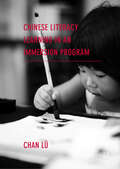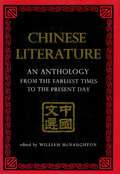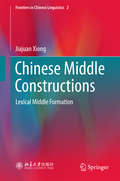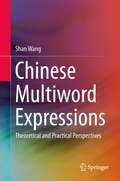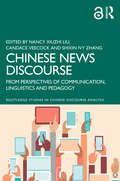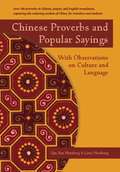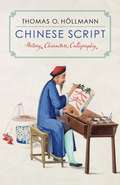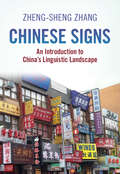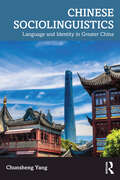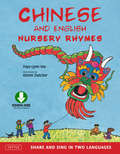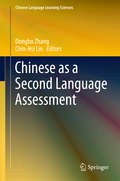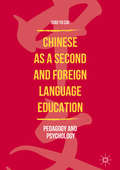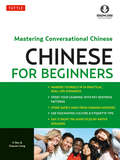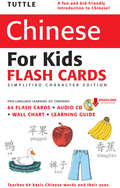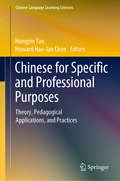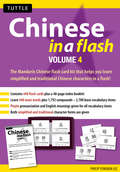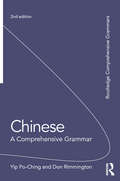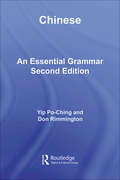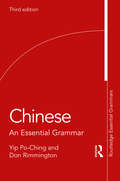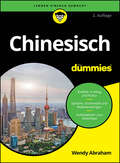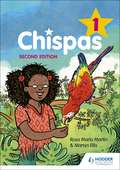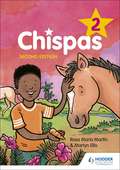- Table View
- List View
Chinese Literacy Learning in an Immersion Program
by Chan LüThis book examines one-way foreign language immersion education in the United States. It provides a clear and rich description of a Chinese (Mandarin) immersion program, its curriculum, instructional materials, assessment activities, parental involvement and student outcomes. The author analyses two studies that document the development of the students’ reading skills in English and Chinese, and the progress of their vocabulary knowledge, lexical inference, and reading comprehension in Chinese. In addition, this book contextualizes the program in its eco-system, including its neighbourhood, school, and the school district, and discusses the importance of school leadership, parental involvement, neighbourhood support and language acquisition planning in making an innovative school program successful. Its concluding chapters offer recommendations for program- and classroom-level practices and suggest pathways for future research on biliteracy learning in Chinese one-way immersion programs. This book will appeal in particular to students and scholars of applied linguistics, second language acquisition and language education.
Chinese Literature
by William McnaughtonAlmost three thousand years of Chinese literature have been gathered together in Chinese Literature: An Anthology from the. Earliest Times to the Present Day. The earliest preserved folk songs of the peasantry; the major works of the "Golden Age" of Chinese philosophy; the "prose-songs" and the later skillful poems of the T'ang dynasty ; the short stories and plays; the novels ; andthe poems and stories of men who have made modern China - all these are represented in this anthology, in complete works or in excerpts.
Chinese Middle Constructions: Lexical Middle Formation (Frontiers in Chinese Linguistics #2)
by Jiajuan XiongThis book defines Chinese middle constructions as generic constructions, with their highest syntactically saturated argument always understood as an arbitrary one. This working definition sets "middle construction" apart from "middle voice" in that it can be instantiated by various constructions in Chinese. By scrutinizing these constructions in the framework of Generative Syntax, the book concludes that their formation takes place at the lexical level, without resorting to any syntactic mechanisms and thus that Chinese falls into the category of "lexical middle languages", which are in contrast to "syntactic middle languages".
Chinese Multiword Expressions: Theoretical and Practical Perspectives
by Shan WangThis book is the first English monograph to systematically explore Chinese Multiword expressions (MWEs) by applying corpus-driven and corpus-based approaches. It reveals the unique characteristics of Chinese MWEs by examining their core attributes, identification and classification, and knowledge framework. It also assesses, for the first time, the distribution and density of Chinese MWEs in textbooks. By doing so, the book provides important insights into Chinese language learning, with implications for natural language processing, lexicography, and psychology. Moreover, it offers a framework for linguists, language teachers and learners, computer scientists, lexicographers, and psychologists to explore their own areas of interest.
Chinese News Discourse: From Perspectives of Communication, Linguistics and Pedagogy (Routledge Studies in Chinese Discourse Analysis)
by Nancy Xiuzhi Liu , Candace Veecock and Shixin Ivy ZhangAs a country in transition, Chinese news discourse has quite distinctive characteristics, and more so given the power of state media in society. With China’s engagement in world affairs and its massive Belt and Road Initiative (BRI) now in place, Western media coverage of China has dramatically increased. Against this backdrop, news dissemination and discourse demonstrate a need for academia to give perspectives with interdisciplinary approaches. Chinese News Discourse presents original research from academics in China and the West, showing theoretical, methodological and practical dimensions between news media and discourse. The book focuses on Chinese news discourse by examining what new modern features it demonstrates in contrast and comparison to news discourses in other countries in the coverage of such hot topics as the BRI or the 70th Anniversary of the Founding of the People’s Republic of China, just to name a few. This book is a useful resource for scholars and students of discourse, language, media and communication studies, as well as translation studies.
Chinese Proverbs and Popular Sayings
by Qin Xue Herzberg Larry HerzbergThis treasury of Chinese wisdom presents over five hundred proverbs while offering keys to culture and language. Here are both the familiar, earnest sayings of Confucius and Lao Zi ("The longest journey begins with a single step") and the homespun truths of every day ("Teachers open the door; you enter by yourself"). Designed both for inspirational browsing and for students of language and culture, the text is organized by subject (Learning, Patience, Money, Family, Food, etc.) and provides commentary plus Chinese characters and pinyin romanization for each entry. Includes an index.Qin Xue Herzberg and Larry Herzberg live in Grand Rapids, Michigan, and are co-authors of the popular China Survival Guide as well as Basic Patterns of Chinese Grammar.
Chinese Script: History, Characters, Calligraphy
by Thomas O. HöllmannIn this brisk and accessible history, sinologist Thomas O. Höllmann explains the development of the Chinese writing system and its importance in literature, religion, art, and other aspects of culture. Spanning the earliest epigraphs and oracle bones to writing and texting on computers and mobile phones today, Chinese Script is a wide-ranging and versatile introduction to the complexity and beauty of written text and calligraphy in the Chinese world.Höllmann delves into the origins of Chinese script and its social and political meanings across millennia of history. He recounts the social history of the writing system; written and printed texts; and the use of writing materials such as paper, silk, ink, brush, and printing techniques. The book sheds light on the changing role of literacy and education; the politics of orthographic reform; and the relationship of Chinese writing to non-Han Chinese languages and cultures. Höllmann explains the inherent complexity of Chinese script, demonstrating why written Chinese expresses meaning differently than oral language and the subtleties of the relationship between spoken word and written text. He explores calligraphy as an art, the early letter press, and other ways of visually representing Chinese languages. Chinese Script also provides handy illustrations of the concepts discussed, showing how ideographs function and ways to decipher them visually.
Chinese Signs: An Introduction to China's Linguistic Landscape
by Zheng-sheng ZhangHighlighting stylistic and rhetorical characteristics, this fully illustrated book explores the written form of Mandarin Chinese in a range of everyday settings. Taking examples from Chinese public writing across a variety of textual genres, such as signs, banners and advertisements, it prepares students for navigating 'real world' Chinese, not only in terms of its linguistic and stylistic characteristics, but also its social and cultural context. Drawing over 500 pictorial examples from the linguistic landscape, it explores the signs from a variety of perspectives, for example by highlighting elements of classical Chinese that are still used in the modern language, showing the most popular rhetorical patterns used in Chinese, and presenting the interactions between both Standard Mandarin and dialect, and Chinese and other languages. Detailed annotations are provided for all signs, in both Chinese and English, to accommodate readers of all proficiency levels in Chinese.
Chinese Sociolinguistics: Language and Identity in Greater China
by Chunsheng YangChinese Sociolinguistics examines the ways in which language contributes to shaping social, cultural, and ethnic identities in Greater China. This book is the first textbook to be exclusively devoted to the issues of language, society, and identity in mainland China, Taiwan, Hong Kong, Singapore, and overseas Chinese communities (the Greater China). The book includes topics on the role of language in Chinese culture; the linguistic indexing of socioeconomic class; dialects and regional language variation; the impacts of state policies; linguistic borrowings; bilingualism and bicultural identity; and language shift and attrition. The emergence of new forms of language as influenced by modern technologies and possible future developments is also discussed in this book. This book will appeal to undergraduate and graduate students taking courses in Chinese sociolinguistics, particularly with a focus on language, identity, and society in Greater China. This book will also be of interest to members of the Chinese Language Teachers Association and the American Council of Teaching Foreign Languages (ACTFL).
Chinese and English Nursery Rhymes
by Faye-Lynn Wu Kieren DutcherThis lovely multicultural book for kids teaches classic fairy tales in both English and Mandarin Chinese.As Mother Goose has known for centuries, rhyme and rhythm are fun! And what could be a more enjoyable way for children and their parents to learn about different cultures and languages than through familiar rhymes and songs?In Chinese and English Nursery Rhymes, an innovative collection of favorite rhymes are put in pairs-one from China and the next in English-to show how the things that kids love are the same, no matter where in the world they live. Whether your native language is English or Chinese, you can learn the rhymes along with your children. Just follow the words on the page, or play the CD and sing along!Nursery rhymes and songs include: Muffin Man Happy Birthday to You I See the Moon As I Was Going Along Hickory Dickory Dock I Love Little Pussy And many more&hellip
Chinese as a Second Language Assessment (Chinese Language Learning Sciences)
by Dongbo Zhang Chin-Hsi LinThis book brings together 13 original research papers that address emerging issues in the assessment of Chinese as a Second Language (CSL) in five major areas, including standards in CSL assessment; development of CSL tests; assessment of diverse knowledge and skills; computer-supported assessment; and CSL assessment in relation to instruction and teachers' assessment competence. It goes beyond the psychometric testing of Chinese and provides cutting-edge examinations of the interfaces of assessment with sociology of language, acquisition, pedagogy, and modern technologies, as well as teacher education. Given its unique features and broad range of topics, the book offers an intriguing and valuable resource, not only for scholars and researchers but also teacher educators and assessment practitioners who are directly or indirectly involved in CSL assessment.
Chinese as a Second and Foreign Language Education: Pedagogy and Psychology
by Qiao Yu CaiThis book presents key issues in the teaching of Chinese as a second or foreign language (TCSL or TCFL). It investigates how multimedia can help to assist TCSL/TCFL and explores practical effects of multimedia-assisted teaching at secondary schools in the Philippines. It addresses the psychology of TCSL/TCFL and discusses various recurring foreign graduate students concerns when learning academic Chinese in graduate institutes in Taiwan. It examines issues of educational assessment and testing, analyzing the validity of a self-made placement test for an immigrant Chinese program, as well as the psychological characteristics of adult learners and their implications for immigrant Chinese curriculum design. As foreign learners of Chinese grow exponentially, this cutting edge read conceptualizes the educational philosophy of TCSL/TCFL as a distinctive discipline.
Chinese for Beginners
by Xiayuan Liang Yi RenThis is an excellent, user-friendly textbook for learning Chinese.Yi Ren has taught thousands of Americans to speak Chinese fluently. Now, she and co-author Xiayuan Liang share their secrets for fast mastery of Mandarin Chinese with you. China has 1.3 billion people and due to initiatives to phase out regional dialects in favor of Mandarin Chinese, nearly all of them can communicate in Mandarin. Don't let yourself be intimidated by this rewarding language. Although it is true that mastery of the Chinese language takes time, Mandarin Chinese actually has simpler grammar than English and there are no conjugations-meaning anyone can learn a few important phrases in no time. Chock full of extra hints and tips drawn from the authors' many years of experience teaching Mandarin Chinese in adult evening classes, Chinese for Beginners focuses on realistic situations you'll encounter when you meet people in China. New words are explained in terms of how you'll actually use them to communicate with new friends. The audio-CD lets you listen and repeat and remember the sentences with ease, and will help you soon declare with pride, "I can say that in Chinese!"Chinese for Beginners includes: Lighthearted approaches that bring Chinese to life in a down-to-earth fashion. Real-life dialogues and situations to help you converse with confidence . An "Extend Your Vocabulary" feature in each chapter helps you to remember and understand more words that you'd think possible . Native-speaker audio recordings teach you to pronounce Chinese tones accurately. Answer Keys help you keep track of your learning process . Interesting notes, idioms, sayings, photos, poems, and insider tips about China's culture, special places, and everyday life add to the adventure.This user-friendly guide to learning the basics will work for anyone who wants to speak and understand Chinese for business, for pleasure, or for travel-and who wants to enjoy the process of learning a new language while they're at it!
Chinese for Beginners
by Xiayuan Liang Yi RenThis is an excellent, user-friendly textbook for learning Chinese. Yi Ren has taught thousands of Americans to speak Chinese fluently. Now, she and co-author Xiayuan Liang share their secrets for fast mastery of Mandarin Chinese with you. China has 1. 3 billion people and due to initiatives to phase out regional dialects in favor of Mandarin Chinese, nearly all of them can communicate in Mandarin. Don't let yourself be intimidated by this rewarding language. Although it is true that mastery of the Chinese language takes time, Mandarin Chinese actually has simpler grammar than English and there are no conjugations-meaning anyone can learn a few important phrases in no time. Chock full of extra hints and tips drawn from the authors' many years of experience teaching Mandarin Chinese in adult evening classes, Chinese for Beginners focuses on realistic situations you'll encounter when you meet people in China. New words are explained in terms of how you'll actually use them to communicate with new friends. The audio-CD lets you listen and repeat and remember the sentences with ease, and will help you soon declare with pride, "I can say that in Chinese!" Chinese for Beginners includes: Lighthearted approaches that bring Chinese to life in a down-to-earth fashion. Real-life dialogues and situations to help you converse with confidence . An "Extend Your Vocabulary" feature in each chapter helps you to remember and understand more words that you'd think possible . Native-speaker audio recordings teach you to pronounce Chinese tones accurately. Answer Keys help you keep track of your learning process . Interesting notes, idioms, sayings, photos, poems, and insider tips about China's culture, special places, and everyday life add to the adventure. This user-friendly guide to learning the basics will work for anyone who wants to speak and understand Chinese for business, for pleasure, or for travel-and who wants to enjoy the process of learning a new language while they're at it!
Chinese for Beginners
by Xiayuan Liang Yi RenThis is an excellent, user-friendly textbook for learning Chinese.Yi Ren has taught thousands of Americans to speak Chinese fluently. Now, she and co-author Xiayuan Liang share their secrets for fast mastery of Mandarin Chinese with you. China has 1.3 billion people and due to initiatives to phase out regional dialects in favor of Mandarin Chinese, nearly all of them can communicate in Mandarin. Don't let yourself be intimidated by this rewarding language. Although it is true that mastery of the Chinese language takes time, Mandarin Chinese actually has simpler grammar than English and there are no conjugations--meaning anyone can learn a few important phrases in no time. Chock full of extra hints and tips drawn from the authors' many years of experience teaching Mandarin Chinese in adult evening classes, Chinese for Beginners focuses on realistic situations you'll encounter when you meet people in China. New words are explained in terms of how you'll actually use them to communicate with new friends. The audio-CD lets you listen and repeat and remember the sentences with ease, and will help you soon declare with pride, "I can say that in Chinese!"Chinese for Beginners includes: Lighthearted approaches that bring Chinese to life in a down-to-earth fashion. Real-life dialogues and situations to help you converse with confidence . An "Extend Your Vocabulary" feature in each chapter helps you to remember and understand more words that you'd think possible . Native-speaker audio recordings teach you to pronounce Chinese tones accurately. Answer Keys help you keep track of your learning process . Interesting notes, idioms, sayings, photos, poems, and insider tips about China's culture, special places, and everyday life add to the adventure.This user-friendly guide to learning the basics will work for anyone who wants to speak and understand Chinese for business, for pleasure, or for travel--and who wants to enjoy the process of learning a new language while they're at it!
Chinese for Business and Professionals in the Workplace: Reaching across Disciplines
by Haidan Wang Christine Uber GrosseThis volume presents a series of the most up-to-date studies on Chinese for Specific Purposes (CSP), an area that has been underrepresented in Language for Specific Purposes (LSP). Drawing from the insights and trends in mainstream theoretical and methodological LSP research, chapters in this volume explore novelties that CSP has developed to prepare Chinese for professional learners for the global economy. These encompass: needs analysis of less-surveyed high school Business Chinese or CSP academic writing classes developments on internationally oriented engineering and internship programs in China innovations in Chinese for business or legal materials development and review on textbook pragmatics studies on language arts and Chinese language use in specific or business settings technology-driven, project-based learning — or discipline-specific curriculum design. Robustly supported by studies and analysis on the global scale, this volume comprises contributions by professionals from universities across Asia and the United States, each with decades of expertise in LSP. These chapters offer critical insights necessary to help LSP researchers and educators rethink curricula and develop new initiatives for LSP. They may also serve as transferable operations that enhance the practice of LSP as a crucial component of second language education.
Chinese for Kids Flashcards Simplified Character Edition
by Tuttle PublishingA fun and kid-friendly introduction to Chinese! The Tuttle MORE Chinese for Kids Flash Cards (Simplified Character Edition) ebook is an introductory language learning tool especially designed to help children from preschool through early elementary level acquire basic words, phrases, and sentences in Chinese in a fun and easy way. The flashcards can be used as a learning tool in a classroom setting, at home, or anywhere that learning takes place, and can easily be taped around the room for an interactive learning experience. The set contains a total of 64 words, which all represent a range of sounds in Mandarin Chinese, organized into thematic categories, including: Going Places, At My House, Things I Like to Do, Actions, Opposites, Weather, and Nature. All of the words are illustrated-the pictures serve as effective visual aids to help children learn and remember each word's meaning. Words often reflect cultural objects and items and can be studied in any order. Learners may focus on one theme at a time or mix them up for a little more variety. Also included in this ebook is downloadable audio which provides native pronunciation of the words, and sample sentences for practice-sentences that children would use in everyday life. Songs and other activities are also included. Finally, the ebook also includes a wall chart featuring the front of each card for kids to review and a learning guide for teachers and/or parents with tips, activities and more!
Chinese for Specific and Professional Purposes: Theory, Pedagogical Applications, and Practices (Chinese Language Learning Sciences)
by Hongyin Tao Howard Hao-Jan ChenThis book, likely the first of its kind in the English language, explores Chinese for specific and professional purposes (CSP) in terms of theorizing and developing practical applications for language teaching and learning. While research in language for specific purposes is thriving for languages such as English, there has been comparatively little such research conducted for Chinese. This volume attempts to fill the gap by bringing together practitioners from a broad international scholarly community, who share common interests yet diverse orientations. Seventeen papers are included, and address four broad thematic categories: (1) academic Chinese, (2) business Chinese, (3) Chinese for medicine and health care, and (4) Chinese for other broadly defined services and industries (diplomacy, tourism, wine-tasting, etc.). Representing the state of the art in CSP research, the book offers an indispensable guide for anyone interested in theoretical and practical issues in this area of applied Chinese language studies.
Chinese in a Flash Volume 4
by Philip Yungkin LeeChinese in a Flash Volume 4 continues to provide more resources for Chinese language students wishing to learn Chinese quickly and easily. This unique set of Chinese flash cards enables learners to acquire more Chinese words and their derivatives in an easy-to-use manner, at a pace to be set by the learners themselves. Common idiomatic expressions are widely distributed among the cards; learners who master these will come to appreciate the beauty of the Chinese language by using a few words to say a thousand different things.
Chinese: A Comprehensive Grammar
by Yip Po-Ching Don RimmingtonChinese: A Comprehensive Grammar is a complete reference guide to Chinese grammar which presents a fresh and accessible description of the language, concentrating on the real patterns of use in modern Chinese. The volume is organized to promote a thorough understanding of Chinese grammar. It offers a stimulating analysis of the complexities of the language and provides full and clear explanations. Throughout, the emphasis is on Chinese as used by present-day native speakers. An extensive index and numbered paragraphs provide readers with easy access to the information they require. The new edition features a revised and expanded chapter on prosody (Prosody and Syntax), as well as four completely new chapters: • Morphology and Syntax (I) looks at Chinese word formation • Morphology and Syntax (II) explores the interaction between words, expressions and sentences • Intralingual Transpositions reviews the possible conversions between sentential constructions • Interlingual Conversions examines the differences between Chinese and English. The Grammar is an essential reference source for the adult learner and user of Chinese. It is ideal for independent study and for use in schools, colleges, universities and adult classes, up to an advanced level.
Chinese: An Essential Grammar (Routledge Essential Grammars)
by Don Rimmington Po-Ching YipThis new edition of Chinese: An Essential Grammar is an up-to-date and concise reference guide to modern Chinese (Mandarin) grammar. Refreshingly jargon free, it presents an accessible description of the language, focusing on the real patterns of use today. This Grammar aims to serve as a reference source for the learner and user of Chinese, irrespective of level, setting out the complexities of the language in short, readable sections. Features include: A new chapter on paragraph development Chinese characters, as well as the pinyin romanization, alongside all examples Literal and colloquial translations in English to illustrate language points detailed contents list and index for easy access to information A glossary of grammatical terms It is ideal either for independent study or for students in schools, colleges, universities and adult classes of all types.
Chinese: An Essential Grammar (Routledge Essential Grammars)
by Yip Po-Ching Don RimmingtonThis new and extended edition of Chinese: An Essential Grammar is an up-to-date and concise reference guide to modern Chinese (Mandarin) grammar. Refreshingly jargon-free, it presents an accessible description of the language, focusing on the real patterns of use today. This Grammar aims to serve as a reference source for the learner and user of Chinese, irrespective of level, setting out the complexities of the language in short, readable sections. It is ideal either for independent study or for students in schools, colleges, universities and adult classes of all types. Features include: Three new chapters on speech habits, writing conventions and new lexicalisation processes Chinese characters, as well as the pinyin romanisation, alongside all examples Literal and colloquial translations into English to illustrate language points Detailed contents list and index for easy access to information A glossary of grammatical terms.
Chinesisch für Dummies (Für Dummies)
by Wendy AbrahamVon Guten Tag bis Auf Wiedersehen: von nǐ hǎo bis zài jiàn Mit diesem Buch lernen Sie Chinesisch sprechen. Los geht’s mit einer Einführung in die Besonderheiten der chinesischen Sprache, in die Betonung sowie in die Grammatik. Dann wird es auch schon praktisch: Sie lernen, wie Sie sich auf Chinesisch vorstellen, etwas beschreiben, telefonieren oder ein Hotelzimmer reservieren. Dabei lernen Sie die wichtigsten Sätze, Umschreibungen und Begriffe, kombiniert mit Informationen zur chinesischen Kultur. Mit kleinen übungen, Verbtabellen, dem im Buch enthaltenen Wörterbuch und den Audiodateien zum Buch können Sie Ihre Sprachkenntnisse festigen. Sie erfahren Welche Besonderheiten der chinesischen Sprache und Kultur Sie kennen sollten Was Sie bei der Aussprache und Betonung beachten sollten Wie Sie auf Chinesisch einkaufen
Chispas Level 1 2nd edn
by Rosa Maria Martin Martyn EllisA primary Spanish course that fosters active communication through the teaching of everyday vocabulary and structures that children can immediately use to talk about their own lives. - Introduces children to Spanish using songs, activities and reinforcement exercises- Develops speaking and listening skills through the use of simple audio texts with visuals- Presents clear lesson objectives and displays new words in attractive Word Boxes- Includes Grammar Boxes which take children through new grammar points they ha ve learned- Provides a variety of stimulating activities, using co-operative learning- Easy to use by both specialist and non-specialist teachers.- Ensure affective use of the series with free teacher's notes available at www.hoddereducation.co.uk/chispas-teachers
Chispas Level 2 2nd edn
by Rosa Maria Martin Martyn EllisA primary Spanish course that fosters active communication through the teaching of everyday vocabulary and structures that children can immediately use to talk about their own lives. - Introduces children to Spanish using songs, activities and reinforcement exercises- Develops speaking and listening skills through the use of simple audio texts with visuals- Presents clear lesson objectives and displays new words in attractive Word Boxes- Includes Grammar Boxes which take children through new grammar points they ha ve learned- Provides a variety of stimulating activities, using co-operative learning- Easy to use by both specialist and non-specialist teachers.- Ensure affective use of the series with free teacher's notes available at www.hoddereducation.co.uk/chispas-teachers
